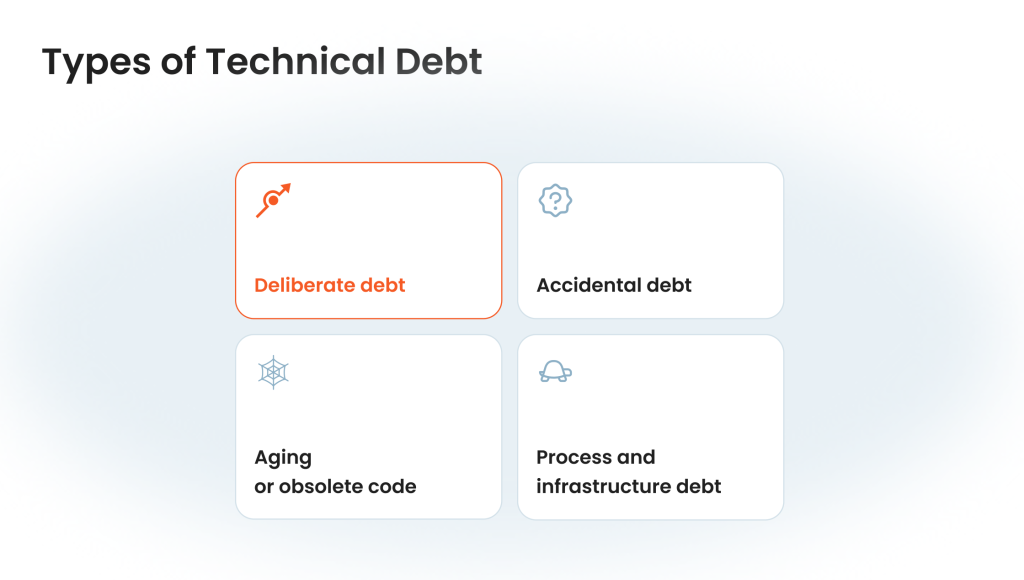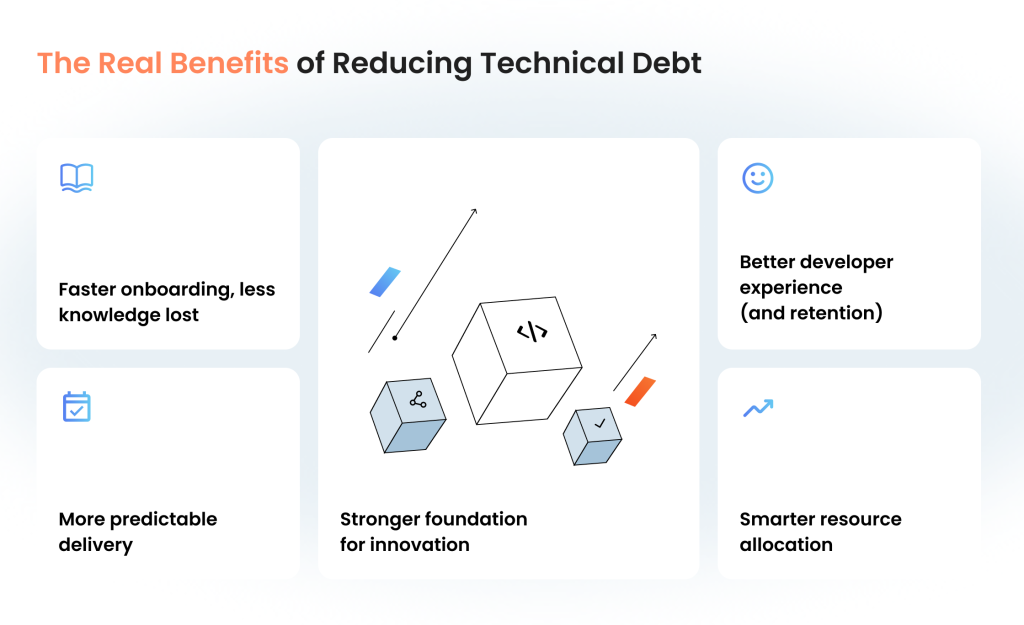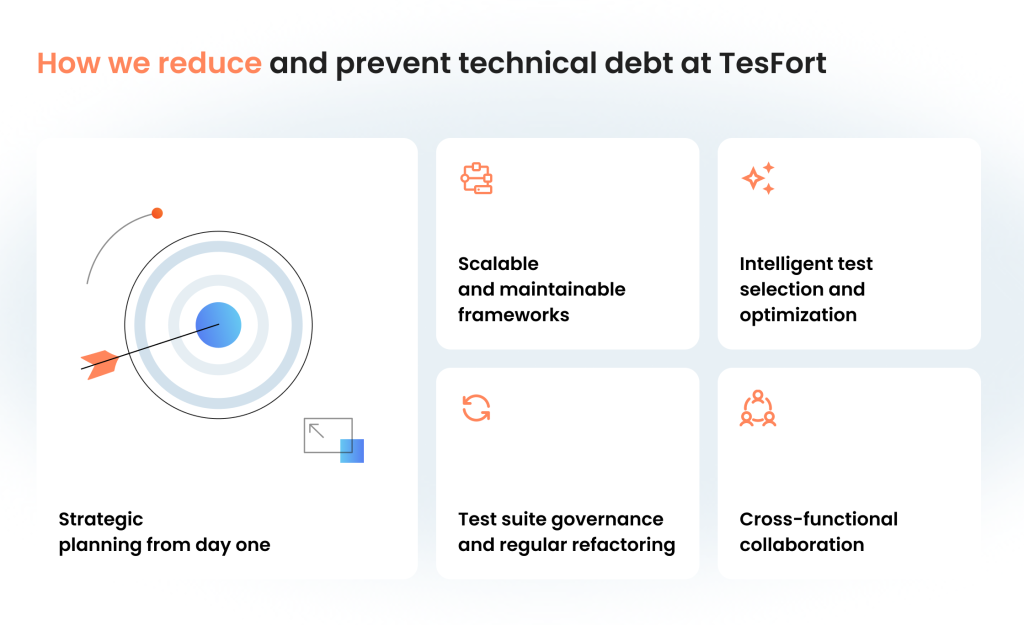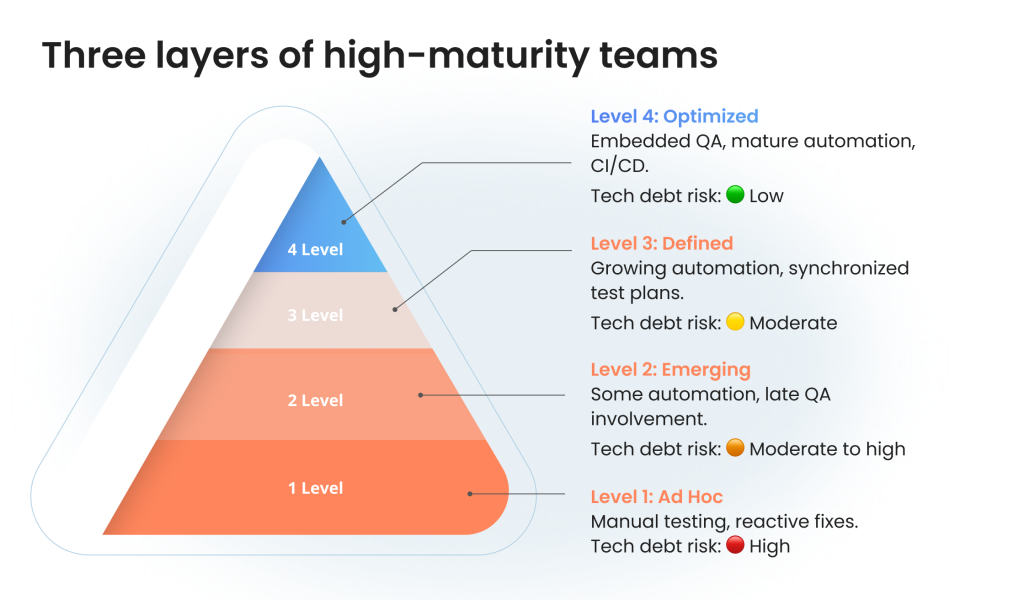In modern Agile environments, speed often takes priority. But speed comes at a cost. When teams cut corners to meet deadlines or skip best practices in favor of quick wins, they accumulate technical debt: invisible compromises that pile up and slow everything down. And while automation is supposed to accelerate delivery, it can just as easily become part of the problem if implemented without a clear strategy.
Today, we are going to explore the dual relationship between test automation and technical debt: how automation contributes to it when done poorly, and how it can help reduce it when done right. We’ll also look at how technical debt affects Agile teams more than most, why process maturity matters, and what development teams can do to stay fast without breaking things. With over 20 years of automation expertise, we are here to help you make automation a long-term asset, not a hidden liability, so let’s look at tech debt in detail and strategies for its reduction together.
Key Takeaways
- Technical debt arises when teams prioritize speed over stability, often skipping best practices to meet deadlines, which results in long-term costs and inefficiencies.
- There are several types of technical debt, including deliberate shortcuts, unintentional mistakes, aging code, and outdated processes or infrastructure.
- Agile teams are particularly vulnerable to technical debt because of fast-paced, iterative delivery cycles that can lead to rushed decisions and neglected cleanup.
- Unmanaged debt can cause delays, recurring bugs, and fragile systems, all of which undermine Agile’s promise of flexibility and speed.
- Reducing technical debt improves developer productivity, onboarding, delivery predictability, and overall innovation capacity.
- Poorly executed test automation creates its own debt through brittle scripts, lack of maintenance, and unclear ownership, often destroying trust in automation.
- Test automation helps manage debt when it’s done well: making issues visible early, preventing regressions, supporting refactoring, and maintaining delivery speed.
- Effective technical debt reduction starts with visibility and prioritization, then follows through with regular refactoring, better collaboration, and embedded quality practices.
- Mature development processes — like integrated QA, structured automation, and strong feedback loops — prevent technical debt and help teams scale sustainably.
What Is Technical Debt?
Technical debt refers to the hidden cost of choosing speed over long-term stability in software development. It happens when teams take shortcuts, skipping best practices, delaying tests, or using quick fixes, to meet tight deadlines or respond to market demands. While this may help deliver faster in the short term, it often leads to growing inefficiencies, increased maintenance costs, and slower progress down the line.
Think of it this way: a team releases a feature quickly without automating related tests. Everything works for now. But over time, as new updates are made, undetected bugs start creeping in. Fixing those issues takes longer, and the lack of test coverage becomes more noticeable as it starts to slow down every release. The decision that seemed to save time in the moment ends up costing more in the long run.
At the same time, technical debt isn’t always a mistake. In some cases, it’s a calculated decision to move quickly and validate ideas. The real problem begins when debt is ignored because, just like financial debt, it accumulates interest. The longer it goes unmanaged, the more it limits your ability to innovate and respond to change.
Struggling With Tech Debt?
An expert-led QA audit will show you a better path forward.
Types of Technical Debt
Technical debt comes in different forms. Some are intentional and some are accidental. But all of them have the potential to impact software quality, team productivity, and long-term costs. Understanding the types of debt can help IT support companies and its managers make smarter decisions about when to move fast and when to invest in stability. Here are the most common types of technical debt that can occur in the development process.

1. Deliberate debt
This is a strategic decision to take a shortcut in order to meet a deadline, test a product idea, or prioritize response to urgent market demands. The team knows there’s a tradeoff and plans to resolve the debt later. An example of deliberate debt would be skipping full automation coverage to launch a new feature quickly, with a plan to build it post-release.
2. Accidental debt
Accidental, or unintentional debt, arises from a lack of knowledge, experience, or oversight. Technical staff may follow outdated practices or build inefficient solutions without realizing the long-term consequences. For example, a new developer introducing complex code that’s hard to maintain, not realizing a simpler pattern exists, is how unintentional technical debt can often occur.
3. Aging or obsolete code
Over time, even well-written code can become debt if it’s not updated. Changes in tools, frameworks, or business needs can render earlier choices inefficient or risky. An application relying on a third-party library that’s no longer maintained, creating compatibility and security risks, is a common example of this type of debt.
4. Process and infrastructure debt
In development and testing, debt isn’t limited to just code debt — it also includes outdated workflows, unscalable environments, or poor test coverage that slows down delivery and increases risk. A frequently occurring example of process debt may be a test suite that takes hours to run because it hasn’t been optimized, causing delays in CI/CD pipelines and productivity issues.
Tech Debt in Agile: Why It Matters Even More
Agile development is designed for speed, flexibility, and continuous delivery. But the things that make Agile such a popular choice among project managers and product owners can create ideal conditions for technical debt to accumulate quickly and quietly.
In Agile, teams move fast. Features are built in short sprints, requirements shift often, and there’s constant pressure to release. That speed can come at a cost: rushed decisions, quick fixes, and postponed clean-up work that piles up over time. When technical debt grows, it slows everything down, resulting in longer sprint cycles, more bugs, increased costs, and frustrated teams.
What makes technical debt even more dangerous in Agile is its invisibility. It rarely breaks builds or causes dramatic failures. Instead, it shows up as inefficiencies:
- Tasks take longer than they should
- Engineers avoid touching fragile code
- Bugs reappear in each release
- Testing becomes a bottleneck
And since Agile teams often rotate or grow quickly, undocumented workarounds and temporary solutions become permanent without anyone noticing.
That’s why managing technical debt isn’t just an engineering task — it’s a leadership responsibility. When left unchecked, debt undermines the very agility businesses rely on to stay competitive.
With the right technical debt management practices, including disciplined test automation, code reviews, and regular refactoring, Agile technical debt can be kept in check. But doing that well requires a long-term mindset, not just a sprint-to-sprint delivery approach.
Don’t Let Debt Slow Down Your Growth
Let our QA experts reduce it without sacrificing speed.
The Real Benefits of Reducing Technical Debt
Reducing technical debt isn’t just a technical exercise — it’s a strategic investment with wide-reaching impact across product, people, and performance. When debt is under control, organizations don’t just ship faster — they operate smarter.

1. Faster onboarding, less knowledge lost
Clean, well-structured code and reliable tests make it easier for new team members to contribute quickly. You reduce reliance on informal knowledge and mitigate risk when key people leave.
2. More predictable delivery
With technical debt reduction resulting in fewer hidden issues and last-minute fire drills, project timelines become more reliable. Planning becomes easier, estimates become more accurate, and stakeholders gain confidence in the roadmap.
3. Better developer experience (and retention)
Teams burdened by messy code and unreliable tests burn out fast. Reducing technical debt gives developers space to innovate, not just fix problems, making it easier to attract and retain top talent.
4. Smarter resource allocation
Instead of sinking hours into rework, debugging, and patching fragile systems, teams can focus on high-impact features and strategic goals, making time and budgets stretch further.
5. Stronger foundation for innovation
The less time you spend untangling old problems, the more time you can spend building what’s next. Reducing debt frees you to modernize tech stacks, adopt new tools, or pivot faster when needed.
Test Automation Debt: Causes and Impact
Automated testing is meant to accelerate delivery and improve software quality, but when handled poorly, it can introduce its own form of technical debt. This debt builds up silently in the background until test scripts become a liability instead of an asset. Here is why technical debt in test automation can appear in the first place:
- Rushed implementation. Writing brittle test scripts under tight deadlines without planning for scalability or maintenance.
- Poor test design. Hard-coded values, duplicated logic, or tests that break with every UI change.
- No maintenance process. Tests are added, but rarely updated or refactored as the application evolves.
- Over-automation. Attempting to automate every test case, including those with low ROI or unstable conditions.
- Lack of ownership. No clear accountability for test health, especially in cross-functional Agile teams.
Here is how automation debt can hinder software delivery and quality:
- Flaky tests and false positives destroy trust in automation, leading teams to ignore test results altogether.
- Longer feedback loops delay defect detection and slow down CI/CD pipelines.
- Higher maintenance costs drain QA resources and reduce the value of automation investments.
- Release risk increases when broken or outdated tests mask real regressions.
In short, automation debt turns what should be a productivity booster into a hidden drag on speed, job satisfaction, and product stability. That’s why we treat automation not as a one-time setup, but as an evolving framework that must be strategically managed.
How we reduce and prevent technical debt at TestFort
Here at TestFort, we don’t just build automated tests — we build sustainable, future-ready automation frameworks that evolve with your product and development process. Preventing and reducing automation debt starts with the right strategy, not just the right tools. Here is how else we deal with tech debt.

1. Strategic planning from day one
Every engagement begins with a deep understanding of your product, architecture, and goals. We align automation priorities with business value to ensure teams aren’t just automating for the sake of it, but making smart, ROI-driven decisions.
2. Scalable and maintainable frameworks
We design modular, reusable test components and follow proven patterns like Page Object Model or BDD. Our frameworks are built to scale and adapt, without any tangled scripts or brittle test chains.
3. Test suite governance and regular refactoring
We treat test code like production code. That means version control, code reviews, and regular refactoring cycles to clean up technical debt before it piles up.
4. Intelligent test selection and optimization
We apply test impact analysis, prioritize high-risk areas, and avoid over-automation. Where appropriate, we integrate AI-driven tools to detect flaky tests and reduce false positives.
5. Cross-functional collaboration
Our QA experts work closely with developers, DevOps, and product owners to ensure test coverage keeps pace with ongoing changes. We embed QA thinking early in the Agile lifecycle to reduce rework and testing gaps, which directly impacts the amount of technical debt.
How Much Debt Is Your AQA Hiding?
We will help you find out and fix it.
How Automated Testing Helps Manage Technical Debt
While poor automation can create its own form of technical debt, well-designed automated testing is one of the most powerful tools for identifying, preventing, and reducing debt across the software lifecycle. Here is exactly how automation can help effectively manage debt in testing.
1. Makes debt visible early
Automated tests serve as living documentation of how the system behaves. When something breaks or changes unexpectedly, the failure surfaces immediately, before that issue has time to cascade into larger, costlier rework.
2. Safeguards against regression debt
In dynamic Agile teams, skipped or rushed regression testing is a common source of technical debt. Automation ensures critical functionality is consistently retested, so new features don’t compromise existing ones.
3. Supports clean refactoring
Debt often accumulates when teams are afraid to touch unstable code. A strong automated test suite gives developers the confidence to refactor, clean up, and modernize systems without the fear of breaking something silently.
4. Enables sustainable delivery speed
Without automation, technical debt slows down every sprint — manual testing piles up, bugs slip through, and releases get delayed. Automation keeps the delivery pipeline flowing by reducing repetitive work and shortening feedback cycles.
5. Establishes a culture of accountability
Automated testing brings structure and consistency to quality practices. It shifts the mindset from reactive fixes to proactive risk management, where teams own quality and debt reduction together.
How to Reduce Technical Debt: Proven Strategies
Reducing technical debt isn’t about stopping progress — it’s about making smarter, more sustainable choices as you grow. The most effective strategies combine technical practices with process discipline and leadership commitment. Here are a few tips to deal with tech debt effectively and create better software products as a result.
1. Start with visibility
When dealing with technical debt, it’s important to remember a simple rule: you can’t reduce what you can’t see. Begin by identifying where debt exists: fragile code, untested features, outdated tools, or recurring sprint bottlenecks.
Regular audits and code quality assessments help surface hidden risks. This includes conducting regular technical debt testing — targeted efforts to identify fragile code, untested components, and automation gaps that could compromise delivery down the line.
2. Prioritize debt like product work
Not all debt is equal. Focus on high-impact areas that slow down delivery, introduce bugs, or affect customer experience. Integrate debt reduction tasks into sprints — don’t leave them in the backlog to rot.
3. Refactor early and often
Refactoring isn’t a luxury — it’s essential maintenance. Encourage teams to clean up code incrementally, especially when making related changes. Small, continuous improvements prevent large-scale overhauls later.
4. Strengthen collaboration between teams
Debt often grows in the gaps between development, QA, and operations. A shared understanding of quality goals — along with test coverage, documentation, and feedback loops — helps prevent the misalignment that creates debt.
5. Build quality into your workflows
Automated testing, CI/CD, code reviews, and definition-of-done criteria are not just engineering best practices — they’re long-term debt prevention tools. The earlier defects and inefficiencies are caught, the less costly they become.
Process Maturity and Tech Debt: What Development Teams Need to Know
Technical debt doesn’t only stem from code — it often reflects the maturity of your development and QA processes. Teams with low process maturity may move quickly in the short term, but they typically incur more debt, encounter more rework, and struggle with long-term scalability.
So, what does low maturity look like?
- Testing starts late — or not at all — until the release deadline looms
- Test cases are undocumented, inconsistent, or handled manually
- Automation exists, but lacks structure, strategy, or maintenance
- There’s no feedback loop between QA, developers, and product owners
- Bugs slip through repeatedly, causing fire drills every sprint
In contrast, mature teams reduce debt by design, not by accident. They build quality into their processes, not just their tools, and apply consistent standards across the lifecycle.
Here is what high-maturity teams look like:
- QA and development are integrated early in the Agile cycle (shift-left)
- Test automation is strategic, maintainable, and regularly reviewed
- Metrics are tracked and used to guide decisions, not just report defects
- There’s a shared understanding of quality, risk, and velocity
- Debt is identified and addressed incrementally, not ignored
Investing in process maturity doesn’t slow you down — it creates the structure that allows teams to scale confidently and deliver faster over time. It also creates the foundation for meaningful automation, sustainable delivery, and proactive debt management.
The bottom line is: The more mature your development and QA processes, the less technical debt you create, and the more equipped your team becomes to manage the debt that does arise.

Final Thoughts: Make Automation Support Agility, Not Tank It
Automation is meant to accelerate Agile teams, not slow them down with brittle test suites, flaky results, and mounting technical debt. Yet that’s exactly what happens when automation is rushed, poorly maintained, or disconnected from broader development goals.
To truly support agility while minimizing technical debt, automation must be strategic, maintainable, and aligned with how your teams work. It should provide fast, reliable feedback that empowers developers, not create unnecessary noise or delays. And it should evolve as your product and processes do, instead of remaining frozen in the original version.
Managing technical debt in Agile isn’t just about code — it’s about mindset. It’s about recognizing that speed and sustainability can coexist, but only when quality is built in from the start.
Jump to section
Hand over your project to the pros.
Let’s talk about how we can give your project the push it needs to succeed!






